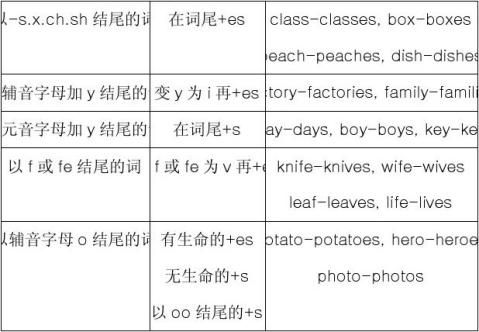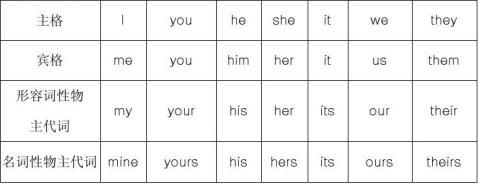1.一般现在时
标志词:always(总是) usually(通常) often(经常) sometimes(有时) never(从不) every(每一)
一般现在时动词只有第三人称单数(he,she,it或my cousin,my mother等等)有词形变化,
其他人称(第一人称:I, we;第二人称:you;第三人称复数:they、my friends)动词均用原形
当主语是第三人称单数(he,she,it或my cousin,my mother等等)时,一般动词在一般现在时句子中的变化规律:
1、多数在动词后加s play—plays like—likes ,
2、以s,x,sh,ch,o结尾的动词加es wash–washes catch–catches do–does
3、以辅音字母加y结尾,把y改i再加es fly—flies study—studies
4、以元音字母加y结尾,直接加s buy – buys
5、不规则变化 have—has
一般现在时基本用法
功能
1.表示事物或人物的特征、状态。 如:The sky is blue.天空是蓝色的。
2.表示经常性或习惯性的动作。 如:I get up at six every day.我每天六点起床。
3.表示客观现实。 如:The earth goes around the sun.地球绕着太阳转。
1
The earth is round.
构成
1. be动词:主语+be(am,is,are)+其它。 如:I am a boy.我是一个男孩。
2.行为动词:主语+行为动词+其它)。 如:We study English.我们学习英语。
句型
肯定句:A.be动词:主语+ be + 其它成分 He is a worker.
B.行为动词:主语+动词(注意人称变化) +其它成分 We like the little cat.
否定句:A.be动词:主语+ be + not +其它成分 They are not students.
B.行为动词:主语+助动词(do/does) + not +动词原形+其它成分
We don’t like the little
cat.
一般疑问句:A.be动词: Am / Is /Are +主语 + 其它成分
Are you a teacher? Yes, I am. / No, I am not.
Are they students of your school.Yes they are
/ No they aren,t.
B.行为动词:助动词(Do/Does)+主语+动词原形 + 其它成分
Do you like it? Yes, I do. / No. I don’t .
Does he(she) like it? Yes, he( she )does. / No,
he ( she )doesn’t.
特殊疑问句:疑问词+ 一般疑问句
2
A.be动词: How many students are there in your school?
B.行为动词:What do you usually do on Sunday?
一般现在时动词be和 have的变化形式
1.动词Be 叫连系动词, 用法:第一人称单数(I)用am,第三人称单数(he,she,it或my cousin,my mother等等)用is,其它人称用are。
2.动词have的用法:第三人称单数(he,she,it或my cousin,my mother等等)用has以外,其它人称一律用have。
2.现在进行时:
标志词:now, look, listen,It’s+时间.
现在进行时: 表示正在进行的、发生的动作
基本结构:
am be is + 动词 ing
are
肯定句:主语 + be动词(am, are, is)+ 现在分词(ing)+ 其他 I am watching TV.
否定句:主语 + be动词+ not + 现在分词(ing)+ 其他 I am not watching TV.
一般疑问句:Be动词(Am, Are, Is) + 主语 + 现在分词(ing)+ 其他
Are you watching TV? Yes, I am. / No, I am not.
3
特殊疑问句:疑问词+ 一般疑问句
What are you doing?
动词的-ing形式的变化规律:
1. 直接加-ing watch—watching clean—cleaning
2. 以-y结尾的动词,直接加-ing
study—studying play—playing
3. 以不发音的-e结尾的动词,先去-e再加-ing
make—making come—coming
4. 末尾只有一个元音字母和一个辅音字母的重读闭音节动词,
双写末尾字母,再加-ing cut—cutting
3.一般将来时
一般将来时的用法:
表示将来某一时刻的动作或状态,或将来某一段时间内经常的动作或状态。 标志词:tomorrow(明天),the day after tomorrow(后天),next (下一个),from now on(从现在开始),in the future(将来),soon(不久)等
结构:
( 1 ) be(am,is ,are) +going to+动词原形
( 2 ) will+动词原形
“be going to+动词原形(打算…)”=”will+动词原形(将,会…)” I’m going to study tomorrow. I will study tomorrow.
4
(be going to着重于事先考虑好 will 未事先考虑好)----一般不用考虑
肯定句:主语 + be (am, are, is) going to + 动词原形.
主语 + will + 动词原形
否定句:主语 + be (am, are, is) not going to + 动词原形.
主语 + won’t + 动词原形.
一般疑问句:Be (Am, Are, Is) + 主语 + going to + 动词原形?
Will + 主语 + 动词原形?
特殊疑问句:疑问词+ 一般疑问句?
注意:will 常简略为 'll,并与主语连写在一起,如:I'll,he'll,it'll,we'll,you'll,they'll。
4.一般过去时
标志词:yesterday(昨天), last (上一个), this morning(今天早上),ago(以前), before (在?之前), in 2002(在20xx年) 等
用法:表示过去某个时间发生的动作或存在的状态,常和表示过去的时间状语连用。也表示过去经常或反复发生的动作
动词过去式变化规则:
1.一般在动词末尾加-ed 如:watch-watched, cook-cooked
2.结尾是e加d 如:taste-tasted
3.末尾只有一个元音字母和一个辅音字母的重读闭音节,应双写末尾的辅音
5
字母,再加-ed,如:stop-stopped
4.以“辅音字母+y”结尾的,变y为i, 再加-ed,如:study-studied
5.不规则动词过去式:am,is-was, are-were, do-did, see-saw, say-said, give-gave…
句型:
1、Be动词在一般过去时中的变化:
⑴am 和is 变为was。 否定(was not=wasn’t)
⑵are 变为were。 否定(were not=weren’t)
否定句:在 was或were后加not
一般疑问句:把was或were调到句首。
2、行为动词在一般过去时中的变化
否定句:didn’t + 动词原形 如:Jim didn’t go home yesterday. 一般疑问句:在句首加Did,句子中的动词过去式变回原形 如:Did Jim go home yesterday?
特殊疑问句:
(1)疑问词+did+主语+动词原形? 如: What did Jim do yesterday?
(2)疑问词当主语时:疑问词+动词过去式? 如:Who went to home yesterday?
6
情态动词
情态动词的定义:情态动词有词义,但它不能单独作谓语,它必须和其他动词一起构成谓语。
情态动词没有人称和数的变化,后加动词原形。
can 能够,会 may 可以 shall 将,要 should 应该 must 必须
have(has)to 不得不 had better 最好 情态动词的用法: 情态动词 can may shall should must have(has)to
肯定句
主语 + can + 动词原形 主语 + may + 动词原形 主语 + shall + 动词原形 主语 + should + 动词原形 主语 + must + 动词原形 主语 + have(has)to
+ 动词原形
情态动词 can may shall
否定句
主语 + can + not + 动词原形 主语 + may + not + 动词原形 主语 + shall + not + 动词原形 主语 + should + not + 动词原形 主语 + must + not + 动词原形 主语 + don’t(doesn’t)+ have(has)to + 动词原形
疑问句
Can + 主语+动词原形?
肯定回答 Yes, ~ can.
否定回答 No, ~ can’t.
May + 主语+动词原形? Yes, ~ may. / Sure. No, ~ may not. No, let’s not. Shall + 主语+动词原形Yes, please. / All right. ?
7
should
must Should +主语+动词原形? Yes, ~ should. Must + 主语+动词原形? Yes, ~ must. No, ~ shouldn’t. No, ~ needn’t. have(has)to Do (does)+主语 + Yes, ~ do (does). No, ~don’t (doesn’t).
have to +动词原形?
名词复数规则
1.一般情况下,直接加-s,如:book-books, bag-bags, cat-cats,
bed-beds
2.以s. x. sh. ch结尾,加-es,如:bus-buses, box-boxes, brush-brushes, watch-watches
3.以“辅音字母+y”结尾,变y为i, 再加-es,如:family-families,
strawberry-strawberries
4.以“f或fe”结尾,变f或fe为v, 再加-es,如:knife-knives
5.不规则名词复数:man-men, woman-women, policeman-policemen, policewoman-policewomen, mouse-mice, child-children,foot-feet,
tooth-teeth,fish-fish, people-people, Chinese-Chinese,
Japanese-Japanese
可数名词变为复数形式有如下变化,如下表:

8
技巧归纳
改f(e)为ve加s口诀
(1)树叶半数自己黄 妻子拿刀去割粮 架后窜出一只狼 就像小偷逃命忙
(2)常用不规则名词复数形式 foot-feet 脚 man-men 男人 woman-women 女人 tooth-teeth 牙 mouse-mice 老鼠 goose-geese 鹅 child-children 小孩
(3)单复数同形 fish 鱼 li 里 jin 斤 yuan 元 mu 亩 sheep 羊 deer 小鹿 Chinese 中国人 Japanese 日本人 means 手段
高频考点 man woman 作定词修饰复数时需变为复数形式
two men doctors 两位男医生 many women leaders 很多女领导
9

(4)只有复数形式,没有单数形式
trousers 裤子 clothes 衣服 shorts 短裤 goods 商品 glasses 眼镜 shoes 鞋
(5)常用不可数名词
advice 建议 baggage 行李 bread 面包 rain 雨 steel 钢 gold 金
sand 沙 grass 草 glass 玻璃 oil 油 paper 纸 butter 黄油
salt 盐 beauty 漂亮 change 零钱 information 信息 smoke water 水 homework 作业 cloth 布 food 食品 money 钱 tea 茶 snow 雪
wealth 财富 furniture 家具 cotton 棉花 rice 大米 fruit 水果 milk 牛奶
代词的用法.

10
主格:一般放在句子前,做主语. ?
宾格:一般放在动词,介词(for、to、of…)后.
形容词性物主代词:修饰名词,放在名词前.?
名词性物主代词:代表名词,后不跟名词.
There be 有,表示存在。
There is+单数、不可数名词 There are+复数
“There be” 句型结构:
肯定句: “ There be+ 主语(某人 / 某物)+ 某地 There isa boy in the room.
否定句: “There be + not (any)+ 主语 + 某地 There aren't any books on the desk.
一般疑问句:“Be(is、are) there +(any)+ 主语 + 某地
“Yes , there is / are.” “No, there isn't / aren't. ”
11
第二篇:牛津小学英语四种时态
现在进行时
一.意义——当表示现在正在进行的动作或正在发生的事。
二.构成: be (am, is ,are )+动词现在分词-ing形式
肯定句:主语 + be + 现在分词V-ing (+ 其他) I’m doing my homework now . 否定句:主语+be+not+动词-ing +其他. I’m not doing my homework now.
一般疑问句:Be+主语+动词-ing +其他?
Are you doing your home work now? Yes, I am . No , I’m not . 特殊疑问句:特殊疑问词+be+主语+动词-ing+其他?
What are you doing now ?
三. 现在分词的构成:
(1)一般在动词末尾直接加ing,
(2)以不发音字母e结尾的动词,先去掉e,再加ing,
如 skate →skating make →making dance → dancing write → writing have → having ride → riding come → coming
(3)以重读闭音节结尾的动词,中间只有一个元音字母,词尾只有一个辅音字母,应双写末尾的辅音字母,再加ing, 如:
putting running beginning stopping
swimming shopping jogging sitting getting forgetting letting 四. 时间标志——now,句前的look ,listen
一般现在时
一. 意义:表示经常发生的事情,动作或存在的状态
二. 构成及变化
1.be动词的变化。
肯定句:主语+be(am,is,are)+其它。如: I am a boy.我是一个男孩。
否定句:主语+ be + not +其它。如:He is not a worker.他不是工人。 一般疑问句:Be +主语+其它。 如:-Are you a student? -Yes. I am. / No, I'm not.
特殊疑问句:疑问词+一般疑问句。如:Where is my bike?
2. 行为动词的变化。
l 当主语为第一,二人称及复数时,助动词为do
肯定句:主语+动词原形(+其它)。如: We often play basketball after school.
否定句:主语+ don't+动词原形(+其它)。如:we don’t play basketball after school.
一般疑问句:Do +主语+动词原形+其它?
如: Do you often play basketball after school l? Yes, we do. / No, we don't.
特殊疑问句:疑问词+以do开头的一般疑问句?
如: What do you often do after school ?
l 当主语为第三人称单数时 , 助动词为does
肯定句:主语+动词三单式(+其它)。如: He swims well.
否定句:主语+ doesn’t+动词原形(+其它)。如:He doesn’t swim well.. 一般疑问句:Does +主语+动词原形+其它。
如:Does he swim well ? Yes, he does. / No, he doesn't. 特殊疑问句:疑问词+以does开头的一般疑问句?
如: How does your father go to work? 三.第三人称单数的动词变化规则(只有在第三人称为主语的肯定句中,动词才用三单式)(1)多数动词直接加s: runs gets likes collets takes plays climbs??.
(2)结尾是s, x, sh, ch, o,前为辅音字母, 结尾加es : watches teaches goes does washes crosses mixes brushes
(3)动词末尾y前为辅音:将y改为i加es: study→studies
fly→flies carry→carries cry→cries
但在y前如果为元音则直接加s: buys says
四.时间标志:always , usually , often , sometimes ,every?
一般过去时
一.意义:表示过去某个时间发生的事情或存在的状态. 常与一般过去时态连用的时间有:
yesterday, yesterday morning (afternoon, evening?) last night (week, month, year?),
a moment ago , a week ago, three years ago? just now,
二.构成及变化
1. Be动词在一般过去时中的变化:
am 和is在一般过去时中变为was。(was not=wasn’t)
are在一般过去时中变为were。(were not=weren’t)
带有was或were的句子,其否定、疑问的变化和is, am, are一样,即否定句在was或were后加not,一般疑问句把was或were调到句首。
2.行为动词在一般过去时中的变化
肯定句 : 主语 + 动词的过去式 . I watched a film last Sunday . 否定句 :主语+ didn’t + 动词原形. I didn’t watch a film last Sunday .
一般疑问句:Did + 主语 + 动词原形 ?
Did you watch a film last Sunday ? Yes, I did . No , I didn’t . 特殊疑问句:疑问词+ 以did 开头的一般疑问句 ? What did you do last Sunday ?
三. 动词过去式变化规则:
1. 规则动词的过去式
(1)一般在动词原形末尾加– ed helped ,looked , played , worked , listened??
(2)结尾是辅音字母+不发音的e,加 – d
lived hoped use---used like --- liked tasted loved closed
(3)双写末尾的字母,再加—ed stop---stopped plan---planned
(4)结尾是辅音字母+y , 先变“y”为“i”,再加—ed
study---studied carry ---carried cry --- cried try---tried 2. 动词过去式的读音规则
(1)在轻辅音后加ed读轻辅音/t/ asked cooked worked looked talked picked watched passed jumped helped surfed
(2)在浊辅音及元音后加ed读浊辅音/d/
lived listened closed opened
stayed watered played
(3)在/t/ /d/ 之后读 /id/ started wanted needed tasted collected 3. 不规则动词过去
式: am,is-was, are-were, do-did, go-went,
see-saw, say-said, give-gave, swim-swam, sit-sat get-got,
come-came, have-had, eat-ate, take-took, run-ran, sing-sang,
put-put, read-read, make-made, write-wrote, draw-drew, drink-drank,
fly-flew, ride-rode, speak-spoke, sweep-swept, find-found tell-told
stand-stood think-thought buy-bought teach-taught
一般将来时
一.意义: 表示将来某个时间要发生的动作或存在的状态,也表示将来经常或重复发生的动作,常与表示将来的时间状语连用。如:tomorrow , soon , next Monday , next year , next weekend , this afternoon , this evening ??
二. 构成及变化
一般将来时常用的两种结构
be going to+动词原形 : 表示打算、准备做的事或即将发生或肯定要发生的事。 shall/will+动词原形 : 表示将要发生的动作或情况,没有太多的计划性, 还用来表示意愿
1. be going to +动词原形
1.肯定句 主语+ be(am /,is,/ are) going to +动词原形+其它成份
My sister is going to learn English next year. 我姐姐准备明年学英语。
2.否定句 主语+be(am / is / are)not going to +动词原形 +其它成份 I am not going to(go to)the cinema tonight. 我今天晚上不打算去看电影。
3.一般疑问句 Be (am / is / are)+主语+going to+动词原型+其它成份?? Is your father going to play basketball with you ?No , he isn’t.你父亲打算和你去打篮球吗?不。
4.特殊疑问句 特殊疑问词(Wh-)+一般疑问句 ?
Where are you going to spend Spring Fesital.? 春节你打算在哪过?
5.注意: be going to 结构后面习惯上不跟 go , come 等表位移的动词,一般用该动词的进行时形式表示。如: He’s going to New York next week.下周他要去纽约.
2. will /shall +动词原形
(在书面语中,主语是第一人称时,常用shall ,在口语中,所有人称都可以用will)
1.肯定句 主语+will/shall+动词原形+其它成份
I (shall) write to him next week. 下周我将给他写信。
2.否定句 主语 + will /shall+ not + 动词原形 +其它成份
They won’t watch TV this evening.今天晚上他们不看电视。
3.一般疑问句 will/shall+主语 +动词原形+其它成份
Will you stay at home with us tomorrow ? 明天你和我们呆在家里好吗?
4.特殊疑问句 特殊疑问词(Wh-) +一般疑问句
When will your father be back? 你爸爸什么时侯回来?
附 : Shall I /we ?常用来征求对方意见,而问对方是否愿意,或者表示客气的邀请,常用Will you??他们的回答比较灵活。
1.Shall we go to the park ? 肯定Sure , let’s go . 否定 No , let’s go to the cinema.
2. Will you please come to my birthday party next week ?
肯定Yes, I will. / Sure . 否定 I’m sorry. I’m afraid I can’t.
